Defensive transition
A defensive transition session. It helps to get players into the habit of reacting immediately after losing possession and works on encouraging the group of players closest to the ball to prevent the opposition from developing an attacking action.
| Area | Up to full pitch |
| Equipment | Balls, bibs, cones, 4 goals |
| No. of Players | Up to 20 players + 4 goalkeepers |
| Session Time |
Warm-up boxes: 10mins, Possession game: 15mins, Possession & transition: 12mins, Pitch switch: 15mins |
This session is about the defensive transition. It helps to get players into the habit of reacting immediately after losing possession and works on encouraging the group of players closest to the ball to prevent the opposition from developing an attacking action.
At all times this session is focused on short sprint reactions in tight areas, which always gives the players a realistic chance of winning back possession or stopping the opposition from scoring, and it requires additional running from the players if this aim is not achieved.
This is a session we would not run too close to match day and we would usually use it when we are due to be playing against opposition that we expect to be focused on counter-attacking play.
WARM-UP BOXES
We set up two 8x8-yard boxes separated by a gap of 1.5 yards. We’re using 10 outfield players, split into eight passing players and one pair of pressers. The possession players are two-touch.
Four passers start in each box and the two pressers start in one of those boxes, making it 4v2 in one box while the possession players pass the ball unopposed in the other box.
If the pressers win possession in the 4v2 box, the player who lost the ball and the player who made the pass into him both sprint into the other box, where they become pressers and try to win possession
from the other four possession players, who have already been passing the ball amongst themselves, as shown [1].
1
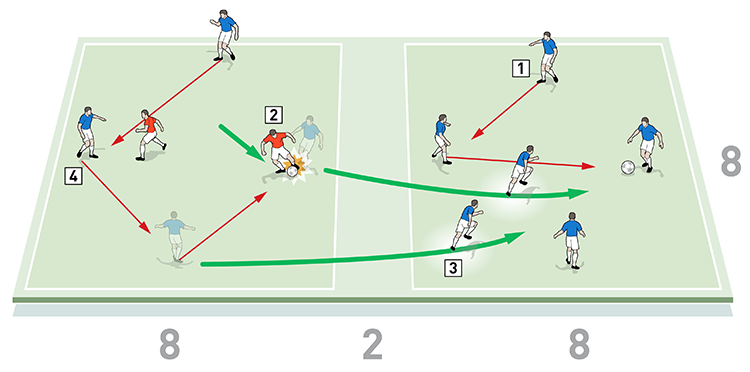
2. It’s 4v2 in one box and two pressers try to win the ball
3. If the pressers win the ball, the player who lost possession and the player who passed to him both sprint into the other box, where they become pressers
4. The original pressers join the possession team in passing the ball unopposed in the first box
In the original box, the first pressing pair now become possession players and continue to pass the ball as a new unopposed group of four.
We play four games of two minutes, with 30 seconds rest in between.
POSSESSION GAME
We set up a playing area of 22x12 yards. We’re using 11 outfield players split into two teams of four plus three floaters. One floater is in the main area and the other two are positioned at each end. We always use goalkeepers as the outside floaters. The two teams of four are one-touch and the three floaters are two-touch.
Play starts with one team passing the ball, assisted by the floaters who always play for the team in possession. The other team presses to win the ball, as shown [2].
2
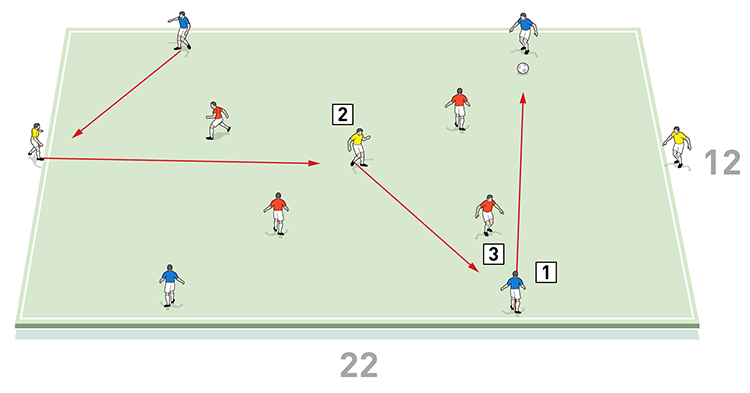
2. The three floaters are two-touch and they play for the team in possession
3. The reds press and if they win the ball, they must keep hold of it under pressure from the blues, who have to perform a forfeit if they fail to win it back within six seconds
The team that loses possession must quickly transition into the pressing role and should try to regain possession as soon as they can, while the original pressing team must now try to avoid the pressure and keep the ball in their possession.
We play four games: two games of 2.5 minutes and two games of 3 minutes, with a minute to rest between each game.
We would alternate the two teams of four as the possession team and we would set them a target of winning the ball back within six seconds should they lose possession.
If they fail to win the ball back in the target time, they are penalised with a punishment of the coach’s choice, such as press-ups.
POSSESSION & TRANSITION
We set up a playing area of 40x36 yards with a goal and goalkeeper at each end. We’re using 10 outfield players, split into two teams of five. The blues are one-touch and they start as the possession team; they must pass to keep hold of the ball with the help of both goalkeepers, who are two-touch. The blues are set a target number of passes they must string together to receive a point. The reds press to gain possession, as shown [3a].
3a
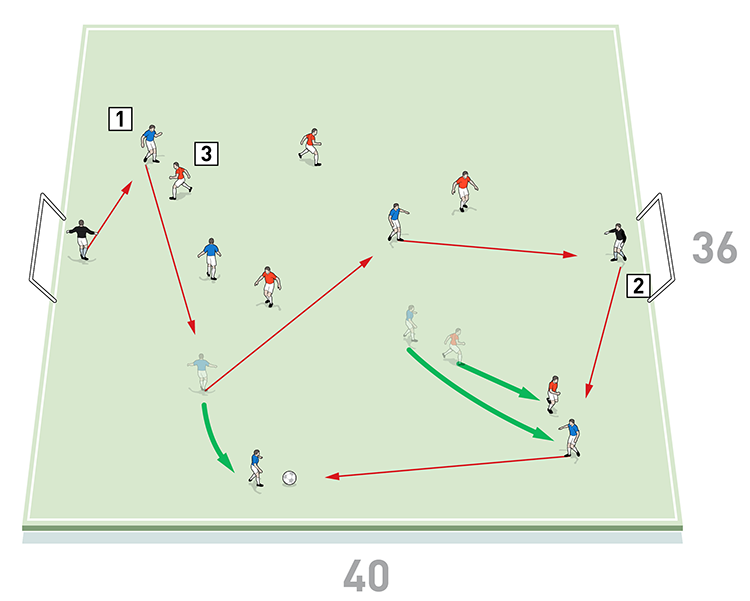
2. The blue possession team pass to keep the ball with the help of both goalkeepers, who are two-touch
3. The reds press to win the ball and they are allowed unlimited touches
When the blues lose the ball, they must
transition quickly to stop the reds (who have no touch limit) from scoring in the goal at the opposite end of the pitch to where they won possession, as shown [3b].
3b
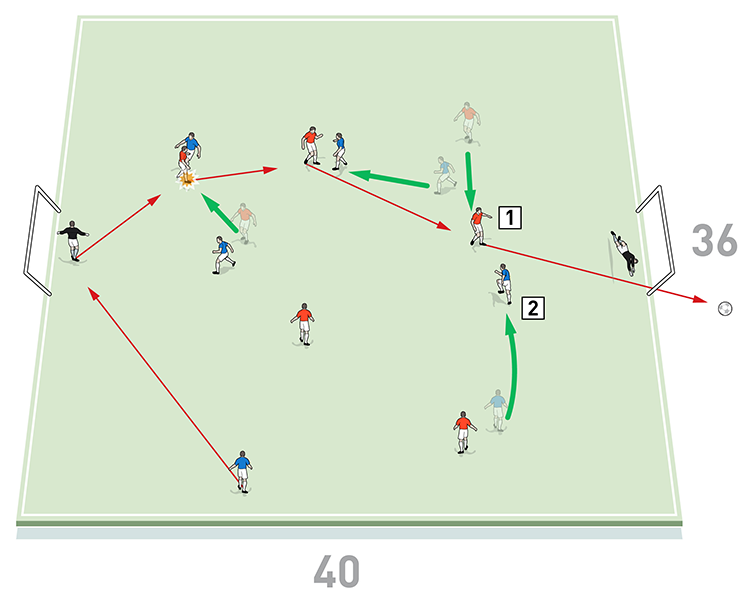
2. The blues must transition quickly to try to stop the reds scoring
As soon as the ball is dead, the blue possession team is served a new ball and play continues in the same manner.
We play four games of two minutes, with one minute to rest between each game. Teams alternate as the possession team in each game.
PITCH SWITCH
We set up two 40x44-yard playing areas, with a goal and a goalkeeper at each end. We’re using 20 outfield players split evenly into reds and blues and we play a 5v5 game on each pitch with no restriction on the number of touches.
Whenever a team concedes two goals in a game on either of the two pitches, as shown [4a], a coach gives a signal and calls out their colour. Both games are stopped and the teams wearing the colour bibs called out by the coach have to quickly switch pitches, as shown [4b]. Play is then restarted. We play for 15 minutes.
4a
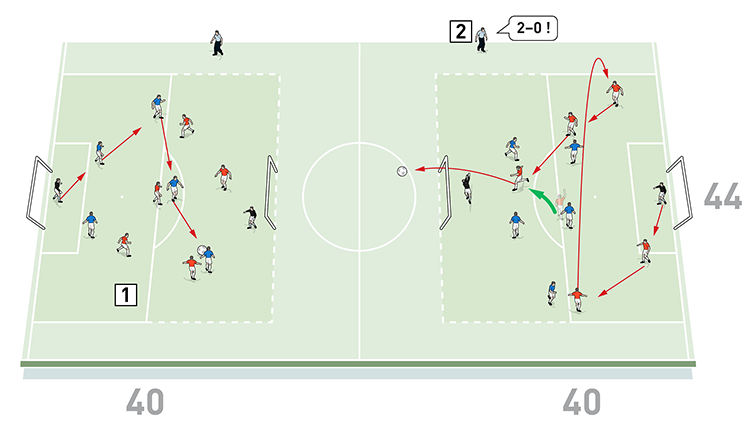
2. When a team concedes two goals in a game on either of the pitches, a coach gives a signal
4b
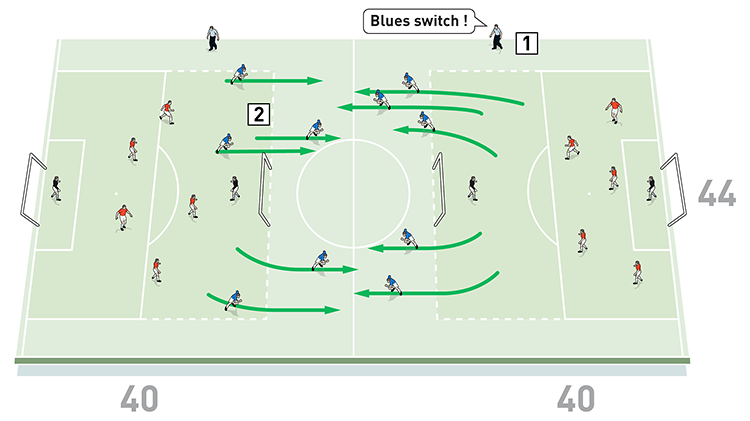
2. Both games are stopped and the teams wearing the colour called by the coach have to quickly switch pitches. Play then restarts
WHAT ARE THE KEY THINGS TO LOOK FOR?
The players in possession of the ball should always be positioned so as to provide good passing options for their team mates. Additionally, they should also always be controlling their surroundings, to be able to react with quality at the moment when they lose the ball.
WHAT ARE THE TYPICAL MISTAKES PLAYERS MIGHT MAKE AND HOW DO I AVOID THEM?
Often players switch off and stand thinking about why they lost the ball instead of reacting and trying to win it back immediately.
Related Files
Editor's Picks
Attacking transitions
Deep runs in the final third
Using the goalkeeper in build-up play
Intensive boxes drill with goals
Penetrating the final third
Creating and finishing
My philosophy
Pressing initiation
Compact team movement
Coaches' Testimonials

Alan Pardew

Arsène Wenger

Brendan Rodgers

Carlos Carvalhal

José Mourinho

Jürgen Klopp

Pep Guardiola

Roy Hodgson

Sir Alex Ferguson

Steven Gerrard
Coaches' Testimonials

Gerald Kearney, Downtown Las Vegas Soccer Club

Paul Butler, Florida, USA

Rick Shields, Springboro, USA

Tony Green, Pierrefonds Titans, Quebec, Canada
Join the world's leading coaches and managers and discover for yourself one of the best kept secrets in coaching. No other training tool on the planet is written or read by the calibre of names you’ll find in Elite Soccer.
In a recent survey 92% of subscribers said Elite Soccer makes them more confident, 89% said it makes them a more effective coach and 91% said it makes them more inspired.
Get Monthly Inspiration
All the latest techniques and approaches
Since 2010 Elite Soccer has given subscribers exclusive insight into the training ground practices of the world’s best coaches. Published in partnership with the League Managers Association we have unparalleled access to the leading lights in the English leagues, as well as a host of international managers.
Elite Soccer exclusively features sessions written by the coaches themselves. There are no observed sessions and no sessions “in the style of”, just first-hand advice delivered direct to you from the coach.









